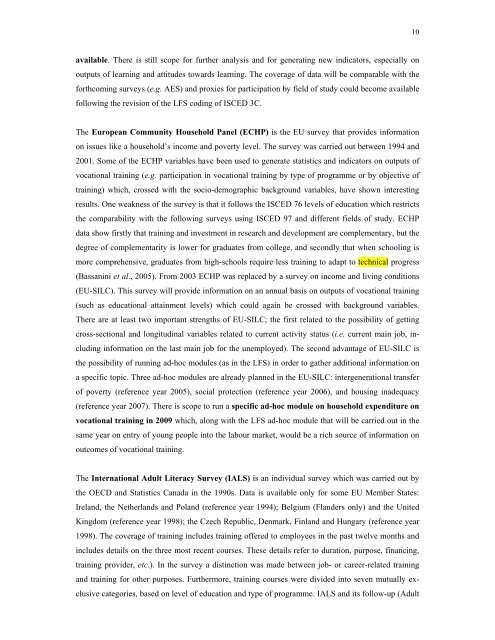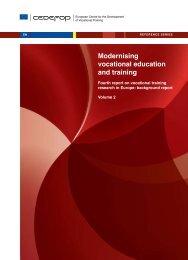measuring the outputs and outcomes of vocational training
measuring the outputs and outcomes of vocational training
measuring the outputs and outcomes of vocational training
You also want an ePaper? Increase the reach of your titles
YUMPU automatically turns print PDFs into web optimized ePapers that Google loves.
10<br />
available. There is still scope for fur<strong>the</strong>r analysis <strong>and</strong> for generating new indicators, especially on<br />
<strong>outputs</strong> <strong>of</strong> learning <strong>and</strong> attitudes towards learning. The coverage <strong>of</strong> data will be comparable with <strong>the</strong><br />
forthcoming surveys (e.g. AES) <strong>and</strong> proxies for participation by field <strong>of</strong> study could become available<br />
following <strong>the</strong> revision <strong>of</strong> <strong>the</strong> LFS coding <strong>of</strong> ISCED 3C.<br />
The European Community Household Panel (ECHP) is <strong>the</strong> EU survey that provides information<br />
on issues like a household’s income <strong>and</strong> poverty level. The survey was carried out between 1994 <strong>and</strong><br />
2001. Some <strong>of</strong> <strong>the</strong> ECHP variables have been used to generate statistics <strong>and</strong> indicators on <strong>outputs</strong> <strong>of</strong><br />
<strong>vocational</strong> <strong>training</strong> (e.g. participation in <strong>vocational</strong> <strong>training</strong> by type <strong>of</strong> programme or by objective <strong>of</strong><br />
<strong>training</strong>) which, crossed with <strong>the</strong> socio-demographic background variables, have shown interesting<br />
results. One weakness <strong>of</strong> <strong>the</strong> survey is that it follows <strong>the</strong> ISCED 76 levels <strong>of</strong> education which restricts<br />
<strong>the</strong> comparability with <strong>the</strong> following surveys using ISCED 97 <strong>and</strong> different fields <strong>of</strong> study. ECHP<br />
data show firstly that <strong>training</strong> <strong>and</strong> investment in research <strong>and</strong> development are complementary, but <strong>the</strong><br />
degree <strong>of</strong> complementarity is lower for graduates from college, <strong>and</strong> secondly that when schooling is<br />
more comprehensive, graduates from high-schools require less <strong>training</strong> to adapt to technical progress<br />
(Bassanini et al., 2005). From 2003 ECHP was replaced by a survey on income <strong>and</strong> living conditions<br />
(EU-SILC). This survey will provide information on an annual basis on <strong>outputs</strong> <strong>of</strong> <strong>vocational</strong> <strong>training</strong><br />
(such as educational attainment levels) which could again be crossed with background variables.<br />
There are at least two important strengths <strong>of</strong> EU-SILC; <strong>the</strong> first related to <strong>the</strong> possibility <strong>of</strong> getting<br />
cross-sectional <strong>and</strong> longitudinal variables related to current activity status (i.e. current main job, including<br />
information on <strong>the</strong> last main job for <strong>the</strong> unemployed). The second advantage <strong>of</strong> EU-SILC is<br />
<strong>the</strong> possibility <strong>of</strong> running ad-hoc modules (as in <strong>the</strong> LFS) in order to ga<strong>the</strong>r additional information on<br />
a specific topic. Three ad-hoc modules are already planned in <strong>the</strong> EU-SILC: intergenerational transfer<br />
<strong>of</strong> poverty (reference year 2005), social protection (reference year 2006), <strong>and</strong> housing inadequacy<br />
(reference year 2007). There is scope to run a specific ad-hoc module on household expenditure on<br />
<strong>vocational</strong> <strong>training</strong> in 2009 which, along with <strong>the</strong> LFS ad-hoc module that will be carried out in <strong>the</strong><br />
same year on entry <strong>of</strong> young people into <strong>the</strong> labour market, would be a rich source <strong>of</strong> information on<br />
<strong>outcomes</strong> <strong>of</strong> <strong>vocational</strong> <strong>training</strong>.<br />
The International Adult Literacy Survey (IALS) is an individual survey which was carried out by<br />
<strong>the</strong> OECD <strong>and</strong> Statistics Canada in <strong>the</strong> 1990s. Data is available only for some EU Member States:<br />
Irel<strong>and</strong>, <strong>the</strong> Ne<strong>the</strong>rl<strong>and</strong>s <strong>and</strong> Pol<strong>and</strong> (reference year 1994); Belgium (Fl<strong>and</strong>ers only) <strong>and</strong> <strong>the</strong> United<br />
Kingdom (reference year 1998); <strong>the</strong> Czech Republic, Denmark, Finl<strong>and</strong> <strong>and</strong> Hungary (reference year<br />
1998). The coverage <strong>of</strong> <strong>training</strong> includes <strong>training</strong> <strong>of</strong>fered to employees in <strong>the</strong> past twelve months <strong>and</strong><br />
includes details on <strong>the</strong> three most recent courses. These details refer to duration, purpose, financing,<br />
<strong>training</strong> provider, etc.). In <strong>the</strong> survey a distinction was made between job- or career-related <strong>training</strong><br />
<strong>and</strong> <strong>training</strong> for o<strong>the</strong>r purposes. Fur<strong>the</strong>rmore, <strong>training</strong> courses were divided into seven mutually exclusive<br />
categories, based on level <strong>of</strong> education <strong>and</strong> type <strong>of</strong> programme. IALS <strong>and</strong> its follow-up (Adult








